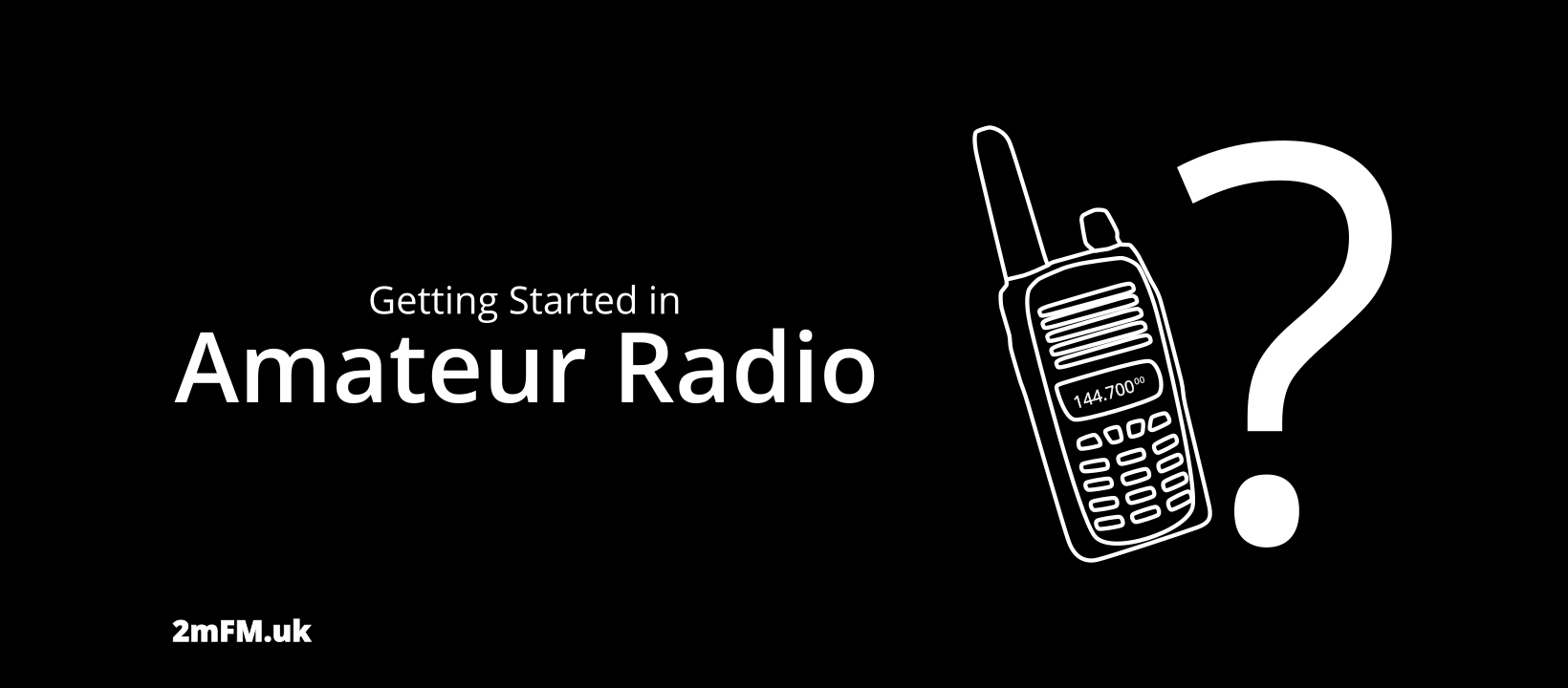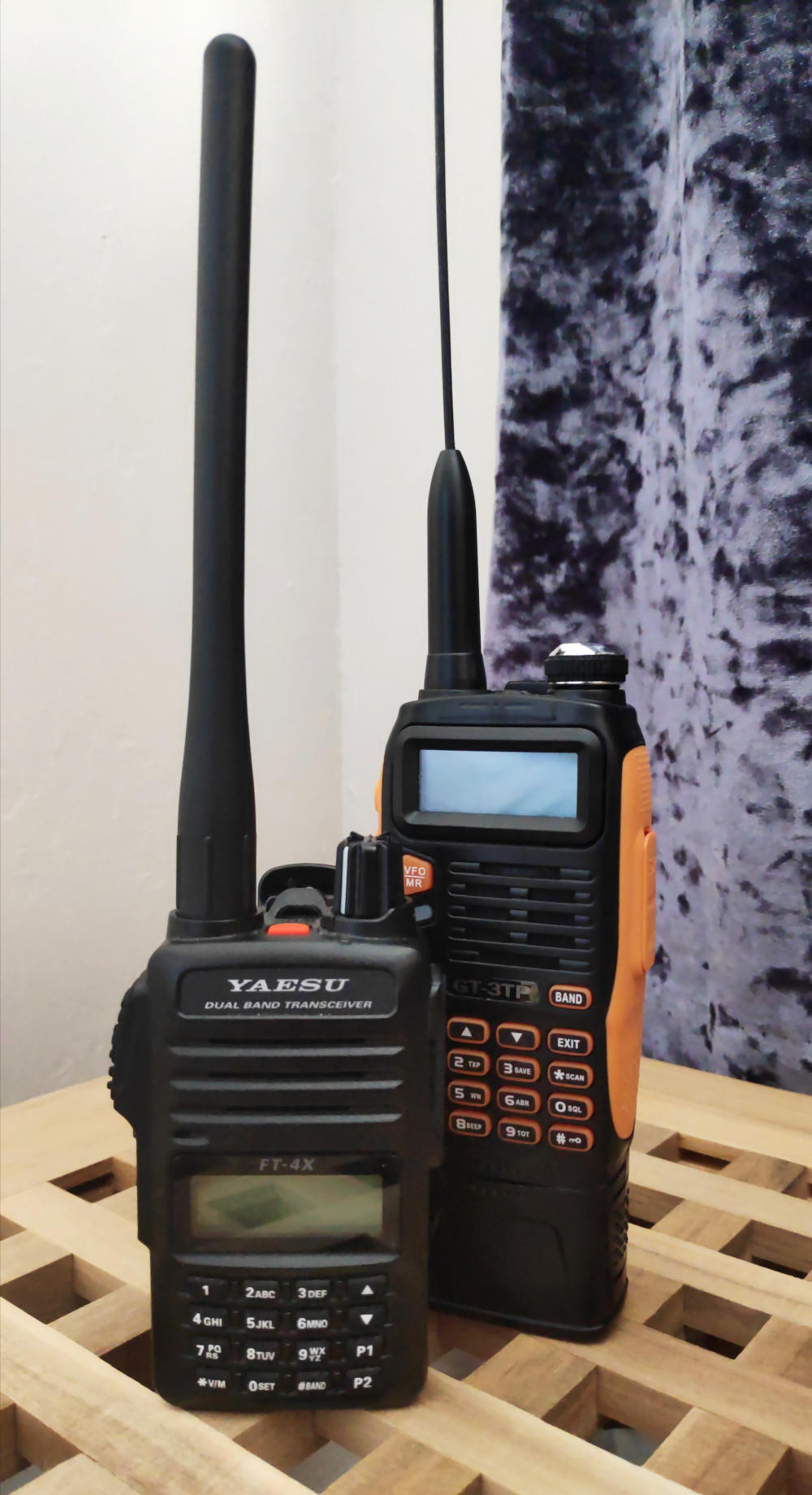Getting Started in Amateur Radio

The 2mFM.uk introductory guide to Amateur Radio.
What is Amateur Radio?
Amateur Radio (or ham radio) is using radio waves to exchange information. As a hobby, it is incredibly varied. It can be as simple as using a walkie-talkie (handheld transceiver or HT for short) to make short-distance voice transmissions (telephony or phone). It can be about making contacts around the world. It can be about experimentation and developing technical ability. In short, Amateur Radio has something to offer everyone.
In addition to telephony, there are various data modes and activities that range from fox-hunting (direction finding) to contesting in various different types of competitions.
You may be interested to read that with fairly inexpensive equipment it is possible to receive images beamed down from the International Space Station (Slow Scan TV or SSTV).
People can legally buy radios and/or scanners that enable them to listen to Amateur Radio transmissions without a license. And even receive those SSTV images from the ISS. Taking the extra step and Obtaining an Amateur Radio license gives people the ability to transmit on Amateur Radio frequencies, in accordance with the terms of their license.
It is perfectly legal to make short-distance voice transmissions without a license using certain radio frequencies with certain types of equipment, for instance using PMR (Private Mobile Radio). Most of the true walkie-talkies are PMR radios. And there are many places where you can get two handsets for as little as £20. PMR radios are limited to a maximum of 500 milliwatts in transmit power. And most radios, at least the handhelds, have an integral and non-interchangeable antenna. These restrictions severely reduce the range and the usefulness of these devices.
Another option is Citizen Band (CB) radio, which again can be used license-free. Although CB radios are less restricted than PMR radios, there are still restrictions that serve to limit their range and flexibility.
In short, Amateur Radio is a lot like PMR or CB radio, but with more flexibility, more users, more modes of communication and the possibility of making global contacts. That makes Amateur Radio a much more fulfilling and rewarding pastime.
Getting Started
There is a great deal of information available on-line about the hobby. There are countless websites, blogs and YouTube channels dedicated to Amateur Radio. The wealth of information can be overwhelming. Fortunately, there are lots of local Amateur Radio clubs up and down the country, almost every area has one.
If you would like a gentle introduction to Amateur Radio, contacting or visiting your local club is highly recommended. Existing members will be willing to help you nurture your new found interest. The Radio Society of Great Britain (RSGB) have a Club Finder which you can use to help find your local club. And there are some clubs in and around Stafford listed in the resources section of this website.
Talking of the RSGB, they have an entire section of their website dedicated to beginners. I found this to be very useful background reading back when I was dipping a toe into the water.
Not everyone will have a local Amateur Radio club, and other people will perhaps struggle with club meeting times, mobility or social anxiety. Or perhaps find themselves stuck at home in the middle of a raging pandemic. Thankfully, Essex Ham provide some fantastic material on their website to help people get started. They even offer a free ‘Foundation Online’ training course which will guide you every step of the way through passing the Foundation License exam and getting your very own call sign. You can find out more about Essex Ham’s ‘Foundation Online’ course on their website.
That is how I and many other Radio Amateurs have got their foundation license exam in recent times.
Exam??? Argh!!!
Fear not because as far as examinations go, the foundation license examination is quite painless. It is possible for most people to learn all of the material in one weekend, or within a couple of hours each week over a number of weeks. The exam itself consists of 26 questions with multiple choice answers. 19 correct answers is the pass mark. You can choose to either sit the exam at home with an on-line invigilator or at an RSGB registered venue (most likely your local Amateur Radio club).
The RSGB provide more information about the exam on their website, which includes a contact number near the bottom of the page for anyone who has any questions. If you have any circumstances which you think would make taking the exam difficult for you, I think it is probably worth giving them a call and talking over your concerns.
All of this talk about exams may sound intimidating, especially with the mention of invigilation. Please do not let that deter you, the reality is nowhere near as daunting as it sounds.
In addition to the Essex Ham ‘Foundation Online’ course mentioned above, there is also another free on-line training course, ‘“Gettin Tae Grips” with the UK Foundation Licence’ course created by William McFarland (GM6DX), which I found to be excellent for revising what I had learned in between taking the Essex Ham on-line course and sitting the exam. After that I would say I was, If anything, over prepared.
There is no fee for an Amateur Radio license itself, but there is a fee to see the exam. At the time of writing, it is £27.50.
I would also recommend purchasing “The Foundation License Manual” from the RSGB Shop, currently priced at £5.99 with a discount for RSGB members. It is not a massive undertaking to read and I would recommend reading the corresponding chapter to go with each module of the Essex Ham Foundation Online Course, week by week.
Once you feel ready to take the exam be sure to undertake a few mock tests. These are really useful for gently nudging you in areas where you might have to do a bit more revision, and otherwise giving you some confidence towards the exam. There are a number of mock tests available with each of the above two courses.
Why is a Licence Required?
Passing the exam and obtaining a license are important steps for any budding Radio Amateur. Setting up and operating an amateur station can cause a range of problems if it is done so incorrectly. It is possible that a badly setup station could cause radio frequency interference (RFI) which interrupts TV reception for nearby neighbours. Or worse, disrupts emergency service transmissions. Further more, there are risks of getting electrocuted or receiving RF burns from improperly or inappropriately used equipment.
That is not to say Amateur Radio is dangerous - it is perfectly safe when simple precautions are applied and sensible care is taken.
What About Cost?
I’ve already discussed the cost of the exam (currently £27.50) and the cost of the “The Foundation License Manual” (currently £5.99). With the license having no fee, the total cost of obtaining your Foundation License is £33.49.
Once you have your license you will want some equipment to operate. It is possible to spend many thousands of pounds on a transceiver and the associated equipment to set up an Amateur Radio station. But that is probably not the best idea, for many reasons. I would recommend, for most people, that they buy a handheld radio, like a Baofeng UV-5R, or better still and just for a bit more money, a Yeasu FT-4XE, just to get started. With that you will be able to listen and transmit on two Amateur Radio bands, 2m (144-146 MHz) and 70cm (420-430MHz). You will be fairly limited in terms of distance, but these radios come so keenly priced, even if you don’t use it much in the longer term, they are worth keeping for backup purposes or for emergency use, perhaps to throw a back pack or keep in the boot of a car. In the short-term, a low cost HT can be used to make local contacts.

Handheld Transceivers:
These HTs are good low cost options for starting out in Amateur Radio
From there, I would suggest building an antenna try with your handheld transceiver. This can be done fairly easily and cheaply with simple tools and commonly available materials. An antenna analyser or MiniVNA (Vector Network Analyser) can be useful for tuning the antenna - a piece of equipment that can be borrowed from your local club, if cost is an issue. The newly built antenna can be connect to the HT with a feeder cable (coax) and an inexpensive pigtail connector. With an external antenna, depending on local geography, it will be possible to make contacts ranging up to 40 or 50 miles away.
It is also worth mentioning that your local club will very likely have a selection of equipment that they will be willing to lend to you. This is very useful for two reasons. First, other club members will be familiar with the equipment and can advise and even help you in setting it up and operating it. Second, it can save you some expense if you decide an avenue of the hobby isn’t right for you. For example, you may borrow a VHF transceiver but decide further on down the line, that you prefer operating on HF instead.
Members of a local Amateur Radio Club will also be able to advise on buying second hand equipment - what to look for and when you find it, whether it is good value.
Like most hobbies, it is possible to spend a great deal on Amateur Radio. Equally it is possible to enjoy the hobby and get a lot out of it without spending significant sums.
Don’t let the potential cost be a factor that deters you from at least putting a toe in the water. If money is seriously tight, speak to your local club. You will find other Radio Amateurs keen to help you get on the air and setup your own station.
The Amateur Radio Community
Amateur Radio has the backing of a helpful, supportive and generous community. It is fair to say, enthusiasts come from all works of life. It has become evident to me, in the short time I’ve been operating, that the majority will willingly go out of their way to help other operators in any aspect of the hobby.
Final Words
I guess with all that, it’s time to sign off.
If, after reading this article, you have any questions or perhaps some suggestions on future content you would like to see, perhaps drop me an email.
Until next time, 731!
-
‘73’ is the morse code abbreviation for ‘Best Regards’ ↩︎